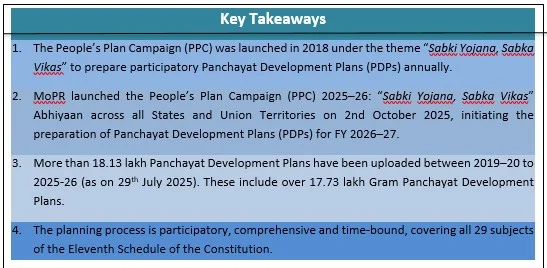People’s Plan Campaign (PPC) 2025–26 | 07 Oct 2025
Why in News?
The Ministry of Panchayati Raj launched the People’s Plan Campaign (PPC) 2025–26: “Sabki Yojana, Sabka Vikas” across all States and Union Territories.
- The campaign initiates the nationwide process of preparing Panchayat Development Plans (PDPs) for the Financial Year 2026–27.
What is the People’s Plan Campaign (PPC)?
- About: Launched on 2nd October 2018, the PPC (also known as jan yojana abhiyan) aims to strengthen participatory, transparent, and accountable local governance by involving citizens in preparing Panchayat Development Plans (PDPs) at the Gram, Block, and District levels.
- Objectives:
- Prepare inclusive and convergent development plans (Gram PDPs, Block PDPs, District PDPs).
- The campaign seeks to achieve effective localization of Sustainable Development Goals (SDGs) by integrating the nine thematic approaches of LSDGs into PDPs and by incorporating Village Prosperity and Resilience Plans (VPRPs) prepared by Self-Help Groups (SHGs) federations.
- To promote gender-responsive governance via Women Elected Representatives (WERs) and community participation.
- It ensures transparency through public information campaigns and Gram Sabha disclosures.
- PPC Achievement: According to the eGramSwaraj Portal, as of July 2025 more than 18.13 lakh PDPs have been uploaded from 2019–20 to 2025-26.
- PPC 2025–26 Highlights:
- Gram Sabhas will review previous GPDPs using eGramSwaraj, Meri Panchayat App, and Panchayat NIRNAY, assess progress, address delays, and prioritize unfinished projects, especially those linked to unspent Central Finance Commission grants.
- The process will be guided by the Panchayat Advancement Index (PAI), supported by SabhaSaar, with a focus on improving Panchayats’ Own Source Revenue (OSR) and enhancing community participation.
- The campaign focuses on tribal empowerment via Adi Karmayogi Abhiyaan, enhancing transparency, accountability, and inclusive rural development.
- Gram Sabhas will review previous GPDPs using eGramSwaraj, Meri Panchayat App, and Panchayat NIRNAY, assess progress, address delays, and prioritize unfinished projects, especially those linked to unspent Central Finance Commission grants.
What is the Role of Panchayats in India’s Development Framework?
- Constitutional Obligation: The Gram Panchayat, as the foundational unit of the three-tier Panchayati Raj system, was institutionalized by the 73rd Constitutional Amendment Act, 1992, to strengthen participatory democracy and decentralized governance in rural India.
- Article 243G empowers Panchayats to plan and implement programs for economic development and social justice, making them autonomous units of local self-government.
- Service Delivery & Welfare: Panchayats are directly responsible for providing essential infrastructure and services, including water supply, sanitation, roads, street lighting, health, education, and nutrition, and for implementing welfare schemes and community development programs.
- Development Planning: Annual Gram Panchayat Development Plans (GPDPs) are prepared in participatory Gram Sabhas, ensuring local priorities are incorporated.
- Plans are comprehensive, covering the 29 subjects of the Eleventh Schedule, and resource-aligned, leveraging Central and State funds.
- Block (BPDPs) and District Panchayat Development Plans (DPDPs) ensure convergence, coordination, and effective scaling of initiatives.
- People's Planning: Self-Help Groups (SHGs) contribute through Village Prosperity and Resilience Plans (VPRPs), embedding community-driven, gender-sensitive, and socially inclusive development approaches.
- Localization of SDGs: Panchayats play a key role by integrating the nine thematic approaches of SDGs (poverty free, healthy, child friendly, water sufficient, clean & green, self-sufficient infrastructure, socially secured, good governance and women friendly villages) into local plans.
- By incorporating these SDG themes, Panchayats act as essential instruments to translate national and global development goals into measurable and impactful outcomes at the grassroots level.
What are the Key Challenges and Actionable Strategies for Improving the Effectiveness of PPC?
|
Challenges |
Actionable Strategies |
|
|
|
|
|
|
|
|
Conclusion
The People’s Plan Campaign is strengthening decentralization by combining community participation with digital planning. PPC 2025–26 can make Panchayati Raj more transparent, inclusive, and accountable, driving equitable rural growth and advancing India’s vision of Viksit Bharat by 2047.
|
Drishti Mains Question: How does the People’s Plan Campaign strengthen participatory governance at the Panchayat level? |
Frequently Asked Questions (FAQs):
1. What is the People’s Plan Campaign (PPC)?
The PPC, launched in 2018, is a nationwide initiative promoting participatory, transparent, and accountable local governance through Gram, Block, and District Panchayat Development Plans.
2. Which constitutional provision empowers Panchayats under PPC?
Article 243G of the 73rd Constitutional Amendment Act, 1992 empowers Panchayats to plan and implement programs for economic development and social justice at the local level.
3. What digital tools are used in PPC 2025–26 for planning and monitoring?
Platforms like eGramSwaraj, Panchayat NIRNAY, Meri Panchayat App, along with Panchayat Advancement Index (PAI) and SabhaSaar, support planning, progress assessment, and community engagement.
UPSC Civil Services Examination, Previous Year Questions (PYQs)
Prelims
Q1. Local self-government can be best explained as an exercise in (2017)
(a) Federalism
(b) Democratic decentralisation
(c) Administrative delegation
(d) Direct democracy
Ans: (b)
Q. The fundamental object of Panchayati Raj system is to ensure which among the following? (2015)
- People’s participation in development
- Political accountability
- Democratic decentralisation
- Financial mobilisation
Select the correct answer using the code given below
(a) 1, 2 and 3 only
(b) 2 and 4 only
(c) 1 and 3 only
(d) 1, 2, 3 and 4
Ans: (c)
Mains
Q. To what extent, in your opinion, has the decentralisation of power in India changed the governance landscape at the grassroots? (2022)
Q. Assess the importance of the Panchayat system in India as a part of local government. Apart from government grants, what sources can the Panchayats look out for financing developmental projects? (2018)
Q. In absence of a well-educated and organised local level government system,`Panchayats’ and ‘Samitis’ have remained mainly political institutions and not effective instruments of governance. Critically discuss. (2015)

